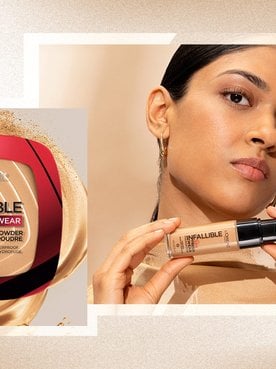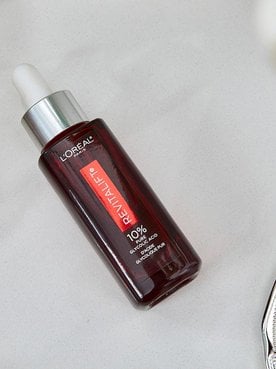If you’ve spent any time on BeautyTok lately, you’ve probably seen creators showing off their glowing red light therapy masks—those futuristic, LED-covered devices that fit over your face like a high-tech sheet mask. Fans say they can do it all: smooth wrinkles, calm breakouts, and give skin a fresh, healthy-looking glow.
But with so many claims swirling around, it’s fair to wonder: do red light masks work as well as people say? Ahead, we’re breaking down what red light face masks actually do, how they benefit your skin, and what to keep in mind before adding one to your routine.
How Do Red Light Therapy Masks Work?
According to the Cleveland Clinic, red light therapy masks use light-emitting diodes (LEDs) to deliver low levels of red and near-infrared light energy to the skin. This light penetrates the skin to help stimulate cellular activity and support the skin’s natural repair processes.
As explained in a study published in the International Journal of Molecular Sciences, wavelengths of light target different skin concerns. Red light (typically around 620–700 nanometers) works on the skin’s surface to help reduce inflammation and can help to calm reactive skin or reduce breakouts. Near-infrared light (around 700–1440 nanometers) penetrates deeper into the skin and may help firm the skin and improve the appearance of fine lines and wrinkles. Some devices even combine multiple wavelengths to tackle several concerns at once.
That said, not all LED red light therapy masks are created equally. At-home versions tend to use lower light intensities and fewer wavelengths than the professional-grade devices found at dermatologists’ offices, med spas, and aesthetic clinics. These in-office treatments typically deliver stronger, more targeted results and can be tailored for your skin’s specific needs.
Red Light Therapy Benefits
Red light masks are relatively new to the beauty world, but the technology behind them has been studied for decades. In fact, NASA researchers first explored red light therapy in the 1990s to stimulate plant growth in space. During their experiments, they noticed that cuts and scrapes on their hands appeared to heal more quickly after exposure to red light. That discovery sparked further research into the therapy’s potential healing benefits—and eventually led to the creation of red light devices for cosmetic use.
Today, fans of red light masks claim these futuristic tools can do everything from reducing wrinkles to brightening dull, tired-looking skin. Not all of these claims are backed by science, but some benefits have been supported by research. According to the American Academy of Dermatology (AAD), red light therapy may:
- Help smooth fine lines and wrinkles
- Reduce clogged pores and acne
- Diminish redness
- Improve skin texture and tone
- Support wound healing
It’s worth noting that while there’s some promising evidence behind these effects, the research is still limited. Most studies focus on professional red light therapy, not at-home masks, so more data is needed to confirm whether consumer devices can deliver the same results.
Are Red Light Face Masks Actually Effective?
Red light face masks are a relatively new skincare technology, so there isn’t yet a large body of evidence confirming their effectiveness. Research suggests they can help address certain skin concerns, but results depend heavily on the specific device, including the wavelengths it uses, the number of LEDs it contains, and how consistently it’s used.
A 2023 study found that using a red light mask consistently twice a week for three months led to a 15.6% reduction in the depth of crow’s feet wrinkles, a 26.4% increase in skin density, and a 12.5% boost in skin elasticity. Another study involving 90 participants reported similar outcomes, with 90% of participants noticing improvements in skin tone and texture. As for acne, one 2025 study published in the Journal of the American Medical Association found that participants who used a red light mask for 12 weeks noticed an improvement in acne severity.
That said, as the Cleveland Clinic points out, the most reliable way to determine a treatment’s effectiveness is through multiple randomized, placebo-controlled trials. So far, there haven’t been enough of these studies to conclusively prove that red light therapy masks reliably improve skin tone or texture, meaning results may vary from person to person. You can still use one—but it’s best to think of it as an add-on to your anti-aging skincare routine rather than your only tool.
Is red light mask therapy safe?
According to the AAD, current research suggests that red light therapy masks are generally considered safe for use. Unlike ultraviolet light, red light and near-infrared light haven’t been shown to cause cancer, and side effects caused by red light therapy tend to be mild—think minor redness or irritation.
With that being said, if you’re using a red light mask, it’s important to choose one that’s been rigorously tested. The best red light therapy masks are extensively tested to ensure safety and efficacy. If you’re buying an at-home mask, look for one that’s labeled as FDA-cleared. This means that the FDA has determined that the product is likely to be safe when used as directed. It’s also a good idea to consult your dermatologist before using any at-home skincare device to ensure it’s suitable for your skin type, concerns, and medical history. They can also provide guidance on how often to use a red light mask to address your specific concerns.
How To Use a Red Light Therapy Mask
The specific instructions for using a red light mask will vary depending on the device and its intensity, so it’s important to read the manufacturer’s guidelines carefully before getting started. That said, here’s a general overview of how to incorporate a red light mask into your regular skincare routine:
1. Cleanse your skin
Start by washing your face with a gentle cleanser to remove dirt, oil, and other impurities. We recommend the L’Oréal Paris RevitaLift Radiant Smoothing Cream Cleanser. It provides gentle exfoliation and removes all traces of dirt and debris to leave your skin feeling soft and smooth. After lathering up, rinse your face well, then pat dry with a clean towel.
2. Put the mask over your face
Next, affix the mask to your face as outlined in the mask’s instruction manual. Usually, they’ll have a strap that wraps around your head to help keep the mask in place. The best red light therapy masks sit flush with your face—the less space between the light and your face, the better the light will be able to penetrate your skin.
3. Wait as directed
Once the mask is in place, all you need to do is sit back and let it work. Keep in mind that how long to wear a red light mask varies depending on the device—some sessions last around five minutes, while others can run up to 30. Always follow the manufacturer’s instructions and set a timer to avoid overexposure, since leaving the mask on for too long may cause temporary redness or irritation.
4. Complete your routine as usual
After your timer goes off, you can go ahead and complete your skincare routine as you normally would. For the best results, we suggest using gentle products that can help further address the skin concerns you’re hoping to target. For example, if you’re using a red light therapy mask for fine lines or wrinkles, use an anti-aging facial serum, such as the L’Oréal Paris Age Perfect Skin Care Serum Le Duo. It’s formulated with vitamin B3, vitamin C, and collagen peptides and helps to smooth, firm, and brighten the skin for a more youthful-looking complexion over time. Once it absorbs, smooth on a gentle moisturizer to help lock in hydration—we love the L’Oréal Paris Age Perfect Skin Care Cell Renewal Midnight Cream. If it’s daytime, go for a formula with broad-spectrum sunscreen, such as the L’Oréal Paris RevitaLift Triple Power Moisturizer with SPF 30. It’ll help protect your skin from damaging UV rays while targeting age-related concerns such as wrinkles and dullness.
How To Choose The Best Red Light Therapy Mask for You
If you’ve decided to take the plunge and splurge on a red light mask, you’ll want to make sure you get the most bang for your buck. Here are a few factors to consider while you shop:
- Price: Red light masks can be a serious investment. Entry-level models typically start around $100, while professional-grade versions can cost $1,000 or more. Before you buy, determine your budget and compare options within that range, paying attention to factors like warranty, clinical testing, and user reviews to ensure you’re getting a good value.
- Format: Full-face red light masks offer the most comprehensive coverage, but they aren’t your only option. There are handheld wands you can glide over your skin and smaller spot-treatment devices designed to target specific areas, like the forehead or jawline. These alternatives tend to be less expensive and are great if you want to focus on one concern rather than your entire face.
- Wavelength: As mentioned, different wavelengths of light address different skin needs. Red light (620-700 nanometers) is commonly used for skin tone, texture, and fine lines, while near-infrared light (around 700–1440 nanometers) penetrates more deeply and can help improve firmness. Decide on your primary skincare goal and choose a device that emits light in the wavelength range that best supports it.
- Number of LED lights: The number of LEDs a mask contains influences both coverage and effectiveness. In general, more lights mean more even distribution of energy across the skin and potentially better results.
- Additional features: Some LED masks let you switch between different light colors—such as blue light for acne, yellow for brightness, or near-infrared for firming—so you can customize treatments based on your skin’s needs. Others include features like automatic shut-off timers, adjustable intensity levels, rechargeable batteries, or even Bluetooth-enabled tracking through companion apps. These extras aren’t essential, but they can make your red light sessions easier, safer, and more effective in the long run.
Common Myths About LED Red Light Therapy Masks
Because they’re relatively new, there are a lot of myths and misconceptions about what red light masks can do. Here, we’re breaking down some of the most common ones—and what the science actually says.
Myth #1: Red light masks can reverse skin aging
No skincare product or device can fully reverse the natural aging process. However, red light masks may help improve some age-related skin concerns, such as fine lines and wrinkles. For the best results, use your mask as directed and maintain a targeted anti-aging skincare routine designed for your skin type and needs.
Myth #2: All red light masks are equally effective
Not all red light masks are created equally, and their effectiveness can vary widely from one device to the next. Factors like light intensity, wavelength range, and overall design all influence how well a mask performs. Since these devices can cost a pretty penny, it’s worth taking the time to research before buying. Read reviews, compare specifications, and look for masks from reputable brands with clinical testing or dermatologist backing to ensure you’re getting the most out of your purchase.
Myth #3: At-home masks can replace in-office treatments
At-home red light masks can be a great addition to your skincare routine, but they’re not a substitute for professional treatments or a well-rounded regimen. These devices offer gentle, gradual benefits with consistent use, whereas in-office treatments typically deliver stronger, more targeted results. Think of your at-home mask as a supportive tool—not a replacement for dermatologist-recommended care or other proven skincare steps.
Next Up: What Is a Facial? At-Home vs. Spa Treatments Explained
Photo courtesy of L’Oréal Paris







